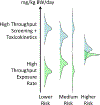New Approach Methodologies for Exposure Science
- PMID: 39748807
- PMCID: PMC11694839
- DOI: 10.1016/j.cotox.2019.07.001
New Approach Methodologies for Exposure Science
Abstract
Chemical risk assessment relies on knowledge of hazard, the dose-response relationship, and exposure to characterize potential risks to public health and the environment. A chemical with minimal toxicity might pose a risk if exposures are extensive, repeated, and/or occurring during critical windows across the human life span. Exposure assessment involves understanding human activity, and this activity is confounded by interindividual variability that is both biological and behavioral. Exposures further vary between the general population and susceptible or occupationally exposed populations. Recent computational exposure efforts have tackled these problems through the creation of new tools and predictive models. These tools include machine learning to draw inferences from existing data and computer-enhanced screening analyses to generate new data. Mathematical models provide frameworks describing chemical exposure processes. These models can be statistically evaluated to establish rigorous confidence in their predictions. The computational exposure tools reviewed here are oriented toward 'high-throughput' application, that is, they are suitable for dealing with the thousands of chemicals in commerce with limited sources of chemical exposure information. These new tools and models are moving chemical exposure and risk assessment forward in the 21st century.
Figures



Similar articles
-
Exposure forecasting - ExpoCast - for data-poor chemicals in commerce and the environment.J Expo Sci Environ Epidemiol. 2022 Nov;32(6):783-793. doi: 10.1038/s41370-022-00492-z. Epub 2022 Nov 8. J Expo Sci Environ Epidemiol. 2022. PMID: 36347934 Free PMC article. Review.
-
The chemical landscape of high-throughput new approach methodologies for exposure.J Expo Sci Environ Epidemiol. 2022 Nov;32(6):820-832. doi: 10.1038/s41370-022-00496-9. Epub 2022 Nov 26. J Expo Sci Environ Epidemiol. 2022. PMID: 36435938 Free PMC article. Review.
-
Computational toxicology as implemented by the U.S. EPA: providing high throughput decision support tools for screening and assessing chemical exposure, hazard and risk.J Toxicol Environ Health B Crit Rev. 2010 Feb;13(2-4):197-217. doi: 10.1080/10937404.2010.483935. J Toxicol Environ Health B Crit Rev. 2010. PMID: 20574897
-
Sources, pathways, and relative risks of contaminants in surface water and groundwater: a perspective prepared for the Walkerton inquiry.J Toxicol Environ Health A. 2002 Jan 11;65(1):1-142. doi: 10.1080/152873902753338572. J Toxicol Environ Health A. 2002. PMID: 11809004 Review.
-
Dietary glycation compounds - implications for human health.Crit Rev Toxicol. 2024 Sep;54(8):485-617. doi: 10.1080/10408444.2024.2362985. Epub 2024 Aug 16. Crit Rev Toxicol. 2024. PMID: 39150724
Cited by
-
Toxicity Assessment of Organophosphate Flame Retardants Using New Approach Methodologies.Toxics. 2025 Apr 11;13(4):297. doi: 10.3390/toxics13040297. Toxics. 2025. PMID: 40278613 Free PMC article. Review.
-
Screening for drinking water contaminants of concern using an automated exposure-focused workflow.J Expo Sci Environ Epidemiol. 2024 Jan;34(1):136-147. doi: 10.1038/s41370-023-00552-y. Epub 2023 May 17. J Expo Sci Environ Epidemiol. 2024. PMID: 37193773 Free PMC article.
-
Enabling transparent toxicokinetic modeling for public health risk assessment.PLoS One. 2025 Apr 16;20(4):e0321321. doi: 10.1371/journal.pone.0321321. eCollection 2025. PLoS One. 2025. PMID: 40238721 Free PMC article.
References
-
- Andersen ME: Toxicokinetic modeling and its applications in chemical risk assessment. Toxicol Lett 2003, 138:9–27. - PubMed
-
- Arnot JA, MacKay D, Webster E, Southwood JM: Screening level risk assessment model for chemical fate and effects in the environment. Environ Sci Technol 2006, 40:2316–2323. - PubMed
-
- Australian Government Department of the Environment and Energy: National Pollutant Inventory. 2019. Available at: http://www.npi.gov.au/ [Accessed].
-
- Aylward LL, Kirman CR, Adgate JL, McKenzie LM, Hays SM: Interpreting variability in population biomonitoring data: role of elimination kinetics. J Expo Sci Environ Epidemiol 2012a, 22:398. - PubMed
Grants and funding
LinkOut - more resources
Full Text Sources
